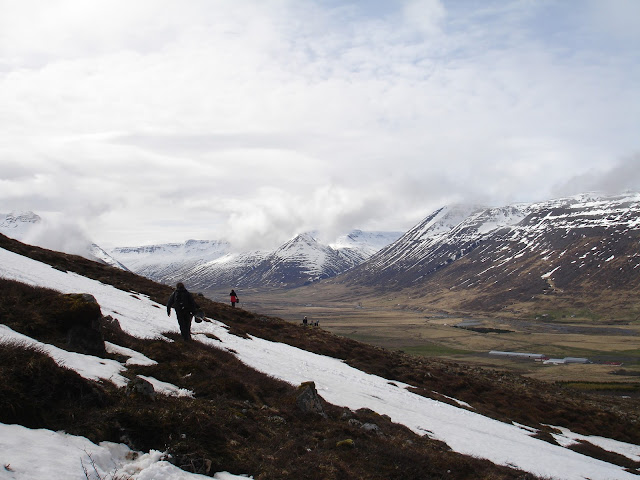
Iceland took up christianity at the beginning of the 11th century. By the beginning of the next it was divided into two episcopal sees, a northern and a southern one. Hólar í Hjaltadal was, from 1106, the episcopal see of northern Iceland. One of its bishops, Jón Arason was one of the, I think, very few casualties in Iceland's comparatively non-violent Reformation. He was beheaded along with his two sons in Skálholt, the see of the southern bishopric in 1550. Thenceforth Iceland adopted Lutheranism.
Though less violent than some other European Reformation conflicts, Iceland's was not without its excitements. There's a neat wiki summary here:
https://en.m.wikipedia.org/wiki/Icelandic_Reformation

Hólar is now a university specialising in Agriculture and Fish Biology, Equestrianism and Rural Tourism. Each year in May members of the ICV leadership team teach a short course on trail work to students on the tourism degree course.
Woodland trail building...
... and stone work on the mountain trails.
On occasion too, Hólar has been the location of ICV's Trail Team training. Here two teams enjoy an outdoor meal in the Spring sunshine.
Auðunarstofa
The bishop's office, Auðunarstofa, was built around 1315 with timber brought from Hólar's estates in Norway. It lasted until 1810 when it was demolished. The present one is a replica, completed in 2002, using original tools and wood from Norwegian forests. Its name commmorates bishop Auðun the Red, 1313-1322.
Nýibær

There is a beautifully preserved turf house here. Built in the mid 19th century it was named Nýibær, meaning 'new farm', to distinguish it from a pre-existing farm. It was lived in until 1945 and has belonged to The National Museum of Iceland since 1958.
Turves are laid in a herringbone pattern.
And just because it's a turf house doesn't mean it's crummy inside.


The current church was built in the 18th century using the beautiful reddish coloured stone from a quarry in the nearby mountainside. The tower, though built of concrete in 1950, sits very well with the church and has a timeless quality about it.
Inside the church there is a connection with my home town:

This Nottingham Alabaster from the 14th century is in Hólar church. Gypsum, the material out of which these carvings are made, is found around Nottingham and many of them are thought to have been made in the locality. The name, though, covers all of this kind of ware no matter where it was made.


Around the year 1000, it was decided at the annual AlÞing that Iceland should be christian. Actually it was not that simple. The matter was controversial: many were committed to paganism and wanted it to continue. The members gave the task of deciding to the Law Speaker, Þorgeir of Ljósavatn. Þorgeir retired from their company, covered himself in a blanket, and spent the next 24 hours in deep thought. Emerging, he announced his very diplomatic solution: Iceland would be officially christian and would abandon paganism. But old practices would be allowed to continue alongside - in private. Further serious conflict was avoided.
Þorgeir was a chieftain-priest from Ljósavatn in the north, not far from Hólar. In a further act of wise diplomacy, he took his pagan idols to a great waterfall nearby and threw them in. The waterfall has since been known as Goðafoss, 'Waterfall of the Gods'.
ICV (Iceland Conservation Volunteers) is the volunteer arm of Umhverfisstofnun, the Icelandic environment agency. The website is:
http://www.ust.is/the-environment-agency-of-iceland/volunteers/
There's a very nice piece about the turf house and other aspects of
Hólar here:
https://guidetoiceland.is/connect-with-locals/regina/holar-in-hjaltadalur-in-north-iceland
Turves are laid in a herringbone pattern.
And just because it's a turf house doesn't mean it's crummy inside.


Inside the church there is a connection with my home town:

This Nottingham Alabaster from the 14th century is in Hólar church. Gypsum, the material out of which these carvings are made, is found around Nottingham and many of them are thought to have been made in the locality. The name, though, covers all of this kind of ware no matter where it was made.


And before Hólar ...
 |
| Modern Church on the Site of Þorgeir's Church at Ljósavatn |
Around the year 1000, it was decided at the annual AlÞing that Iceland should be christian. Actually it was not that simple. The matter was controversial: many were committed to paganism and wanted it to continue. The members gave the task of deciding to the Law Speaker, Þorgeir of Ljósavatn. Þorgeir retired from their company, covered himself in a blanket, and spent the next 24 hours in deep thought. Emerging, he announced his very diplomatic solution: Iceland would be officially christian and would abandon paganism. But old practices would be allowed to continue alongside - in private. Further serious conflict was avoided.
Þorgeir was a chieftain-priest from Ljósavatn in the north, not far from Hólar. In a further act of wise diplomacy, he took his pagan idols to a great waterfall nearby and threw them in. The waterfall has since been known as Goðafoss, 'Waterfall of the Gods'.
 |
| Looking out across the lake, Ljósavatn, from Þorgeir's church |
http://www.ust.is/the-environment-agency-of-iceland/volunteers/
There's a very nice piece about the turf house and other aspects of
Hólar here:
https://guidetoiceland.is/connect-with-locals/regina/holar-in-hjaltadalur-in-north-iceland















No comments:
Post a Comment
Note: only a member of this blog may post a comment.